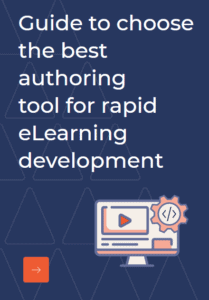When Abraham Lincoln delivered Gettysburg Address on November 19, 1863, he probably wished to honour the brave union soldiers who had been killed in the battle and lend solace to those who were left behind. 155 years later the words that he spoke, including the very famous quote, “Government of the people, by the people, for the people, shall not perish from the Earth”, still echoes through nations, strengthening democracies across the globe.
A powerful notion indeed, considering the fact that when all the components and the heart is at right place, what is created by people (the product designers/developers etc.) carries a humanistic influence that is delivered to the people (the consumers). Stands true for eLearning too. But, does eLearning essentially end up being ‘for the people’? While the answer often comes in terms of learner participation, engagement, knowledge retention and behavioural change, the learner- centered label often appears only in theory.
However, with the current changes in technology, attitude of learners and the overall L&D scenario, the whole eLearning design, development and deployment process now essentially needs a learner-centric twist. And here’s why.
- Inculcates Learner Autonomy: Though a term more prevalently used in the field of language training, learner autonomy stands for a flipped learning structure wherein the instructor-learner equation is reversed. Here the learners drive their own learning experience, and the success of the strategy hinges on the learner’s ability to take charge. Such an opportunity can only be created when eLearning content and delivery platform both are learner centric.
- Ensures Participation: It is well known that eLearning works only if the target audience or the learners participate. A learner-centric approach ideally revolves around creating personalized eLearning experiences, that can be accessed with ease on different devices. Starting from the interface to relevant content all aspects play crucial role in making eLearning truly learner-centric, and ensures that learners actively participate in the learning process, i.e. interaction and engagement guaranteed.
- Improves Knowledge Retention: Relevant content, active participation and that too self-driven, the perfect combination of knowledge retention right? The learner centered approach is all about involvement, interaction as a process of learning and not a forced inclusion. Hence, the use of real-life scenarios, storytelling, branched scenarios etc. that give the learners a closer understanding about the context, the content and a clear picture about the situations that may call for implementation of the knowledge acquired, and hence improved retention.
- Bridges Skill-gaps & Improves Performance: A continuation to the point discussed above. The learning acquired through eLearning that is learner centred targets the skill gaps and as a result often leads to better performance at work. It improves the problem solving skills, and initiates behavioural changes that are beneficial at an organizational level too.
- Boosts the Morale: The audience or the learners, usually the employees of an organization feel valued when their individual concerns are addressed. A Learner-centric eLearning harnesses this to boost the morale of the employees and allow them to gain personal benefit through knowledge. This in turn gives the employees a sense of accomplishment and satisfaction which often goes a long way both in terms of employee retention and overall performance.
While the whole process of eLearning is learner-oriented, very often eLearning ends up being either content heavy, or non-contextual, text heavy etc. Learner-centric eLearning however, focuses on these very aspects revolving around key questions about the learners such as:
- Who are the target audience?
- What is their level of understanding? The existing technical know-how?
- What are the preferred and effective learning interactions?
- What is the learning goal? etc.Questions that essentially give a clear picture about the target audience and the learning ecosystem and help to build on past experiences to create something that truly connects with the learners, helps them learn at their own pace, absorb the learning and apply it in the day-to-day functions. Hence, to create learning that is of the people, by the people and for the people, instructional designers should be able to identify the learning needs precisely, put themselves in the learner’s shoes while conceptualizing and designing, and the developers, graphic designers should add value to it.Enjoy what you read? Do share your comments below.



